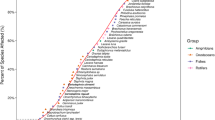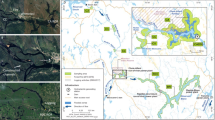Abstract
Recent debate concerning the modification of safe drinking water standards for arsenic (As) has led to increased awareness of the risks As poses to both humans and the environment. However, few studies have examined the effects of As on the diversity and composition of aquatic assemblages in streams. Benthic macroinvertebrate surveys, chemical analysis of water column and sediment, and laboratory toxicity tests were conducted to assess effects of an abandoned As mine on a headwater stream, and to determine the primary component of toxicity. The average 48-hr LC50 value for Daphnia magna was 4316 μg As/L, and the average 96-hr LC50 value for Lepidostoma spp. was 2138 μg As/L. Reproduction was significantly reduced for D. magna at concentrations ≥312 μg As/L in water column laboratory bioassays, and for treatments in bioassays with sediments containing elevated As (≥2630 mg/kg). These results support the findings of the in-stream benthic macroinvertebrate survey as the density and percent Ephemeroptera + Plecoptera, + Trichoptera (EPT) were substantially lower at sites downstream of the mine compared to upstream reference sites. Results of bioassays comparing the toxicity of As-contaminated site water and upstream reference water spiked with As salts suggest that As is the primary component of toxicity impacting the stream. Measured As concentrations at downstream sites were above the recommended Criterion Maximum Concentration of 340 μg As/L and Criterion Continuous Concentration of 150 μg As/L for protection of aquatic life published by the United States Environmental Protection Agency. At the study site, elevated As concentrations likely prevent recruitment of benthic macroinvertebrates and recovery of the perturbed headwater stream.



Similar content being viewed by others
References
American Society of Testing and Materials (1995) Standard methods for measuring the toxicity of sediment-associated contaminants with fresh water invertebrates. E 1706-95b
Biesinger KE, Christensen GM (1972) Effects of various metals on survival, growth, reproduction and metabolism of Daphnia magna. J Fish Res Board Can 29:1691–1700
Canivet V, Chambon P, Gilbert J (2001) Toxicity and bioaccumulation of arsenic and chromium in epigean and hypogean freshwater macroinvertebrates. Arch Environ Contam Toxicol 40:345–354
Chaffin JL (2003) The influence of elevated arsenic concentrations on stream biota and leaf breakdown in a headwater stream. Master’s thesis. Department of Biology. Virginia Polytechnic Institute and State University, Blacksburg, Virginia
Chaffin JL, Valett HM, Webster JR, Schreiber ME. The influence of elevated arsenic on leaf breakdown in an Appalachian headwater stream. J N Am Benthic Soc (in press)
Clements WH (1999) Metal tolerance and predator-prey interaction in benthic macroinvertebrate stream communities. Ecol Appl 9:1073–1084
Clements WH, Carlisle DM, Lazorchak JM, Johnson PC (2000) Heavy metals structure benthic communities in Colorado mountain stream.
Clements WH, Carlisle DM, Courtney LA, Harrahy EA (2002) Integrating observational and experimental approaches to demonstrate causation in stream biomonitoring studies. Environ Toxicol Chem 21:1138–1146
Courtney LA, Clements WH (2002) Assessing the influence of water and substratum quality on benthic macroinveretebrate communities in a metal-polluted stream: An experimental approach. Freshwater Biol 47:1766–1778
Dietrich R (1959) Geology and mineral resources of Floyd Country of the Blue Ridge Upland, southwestern Virginia. Engineering experiment station series no. 134, Virginia Polytechnic Institute, Blacksburg, Virginia
Fargasova A (1994) Toxicity of metals on Daphnia magna and Tubifex tubifex. Ecotoxicol Environ Safety 27:210–213
Gomi T, Sidle RC, Richardson JS (2002) Understanding processes and downstream linkages of headwater systems. BioScience 52:905–916
Hare L (1992) Aquatic insects and trace metals: Bioavailability, bioaccumulation, and toxicity. Crit Rev Toxicol 22:327–269
Hare L, Tessier A, Campbell PGC (1991) Trace elements distribution in aquatic insects: Variation among genera, elements, and lakes. Can J Fish Aquat Sci 48:1481–1491
Jeyasingham K, Ling N (2000) Acute toxicity of arsenic to three species of New Zealand chironomids: Chironomus zealandicus, Chironomus sp. and Polypedilum pavidus (Diptera, Chironomidae). Bull Environ Contam Toxicol 64:708–715
Kiffney PM, Clements WH (1996) Size-dependent response of macroinvertebrates to metals in experimental streams. Environ Toxicol Chem 15:1352–1356
Lenat DR, Barbour MT (1994) Using benthic macroinvertebrates community structure for rapid, cost-effective, water quality monitoring: Rapid bioassessment. In: Loeb SL, Spacie A (ed). Biological monitoring of aquatic systems. Lewis, Boca Raton, Florida, pp 187–215
Lima AR, Curtis C, Hammermeister DE, Markee TP, Northcott CE, Brooke LT (1984) Acute and chronic toxicities of arsenic (III) to fathead minnows, flagfish, Daphnids, and an amphipod. Arch Environ Contam Toxicol 13:595–601
Merritt RW, Cummins KW (eds) (1996) An introduction to the aquatic insects of North America. 3rd ed. Kendall/Hunt Publishing Company, Dubuque, Iowa
National Academy of Sciences (1977) Arsenic, Committee on medical and biological effects of environmental pollution. Division of Biological Sciences. Assembly of Life Sciences National Research Council. Philadelphia, Pennsylvania
Nordstrom DK (2002) Worldwide occurrences of arsenic in ground water. Science 296:2143–2145
Platt JR (1964) Strong inference. Science 146: 347–353
Resh VH, Jackson JK (1993) Rapid assessment approaches to biomonitoring using benthic macroinvertebrates. In Rosenberg DM, Resh VH (eds) Freshwater biomonitoring and benthic macroinvertebrates. Chapman and Hall, New York, pp 195–223
Robb GA, Robinson JDF (1995) Acid drainage from mines. Geograph J 161:47–54
Schreiber ME, Valett HM, Chaffin J (2002) Hydrogeochemical controls of arsenic discharges to a headwater stream near and abandoned arsenopyrite mine. Geological Society of America Abstracts with Programs, 34:p 51
Schultheis AS, Sanchez M, Hendricks AC (1997) Structural and functional responses of stream insects to copper pollution. Hydrobiologia 346:85–93
Smedley PL, Kinniburgh DG (2002) A review of the source, behavior, and distribution of arsenic in natural water. Appl Geochem 17:517–568
Smith AH, Lopipero PA, Bates MN, Steinmaus CM (2002) Arsenic epidemiology and drinking water standards. Science 296:2145–2146
Tisler T, Zagorc-Koncan J (2002) Acute and chronic toxicity of arsenic to some aquatic organisms. Bull Environ Contain Toxicol 69:421–429
United States Environmental Protection Agency (1984) Ambient water quality criteria for arsenic. PB85-227445. Washington, DC
United States Environmental Protection Agency (1991) Methods for the determination of metals in environmental samples. EPA/600/4-91/010. Washington, DC
United States Environmental Protection Agency (1993) Methods for measuring the acute toxicity of effluents and receiving waters to freshwater and marine organisms—4th ed. EPA/600/4-90/027F, Washington, DC
United States Environmental Protection Agency (1994) Short-term methods for estimating the chronic toxicity of effluents and receiving waters to marine and estuarine organisms. EPA/600/4-91/003. Washington, DC
United States Environmental Protection Agency (1999) National recommended water quality criteria—correction. EPA/822/Z/99/001. Washington, DC
Vuori KM, Kukkonen J (1996) Metal concentrations in Hydropsyche pellucidula larvae in relation to the anal papillae abnormalities and age exocuticle. Wat Res 30:2265–2272
Walker FP (2004) Kinetics of arsenopyrite oxidative dissolution by oxygen. Master’s thesis. Department of Geosciences, Virginia Polytechnic Institute and State University, Blacksburg, Virginia
Wallace JB, Grubaugh JW, Whiles MR (1996) Biotic indices and stream ecosystem processes: Results from an experimental study. Ecol Appl 6:140–151
Welch AH, Westjohn DB, DR Helsel, RB Wanty (2000) Arsenic in ground water of the United States: Occurrence and geochemistry. Ground Water 38:589–604
Winner RW, Boesel MW, Farrell MP (1980) Insect community structure as an index of heavy metal pollution in lotic ecosystems. Can J Fish Aquat Sci 37:647–651
Acknowledgments
We thank the Virginia Tech Stream Team, Aquatic Ecotoxicology, and Hydrogeosciences labs for assistance at various times throughout this research. This work was supported by NSF award EAR-0207784.
Author information
Authors and Affiliations
Corresponding author
Rights and permissions
About this article
Cite this article
Valenti, T.W., Chaffin, J.L., Cherry, D.S. et al. Bioassessment of an Appalachian Headwater Stream Influenced by an Abandoned Arsenic Mine. Arch Environ Contam Toxicol 49, 488–496 (2005). https://doi.org/10.1007/s00244-004-0222-x
Received:
Accepted:
Published:
Issue Date:
DOI: https://doi.org/10.1007/s00244-004-0222-x




